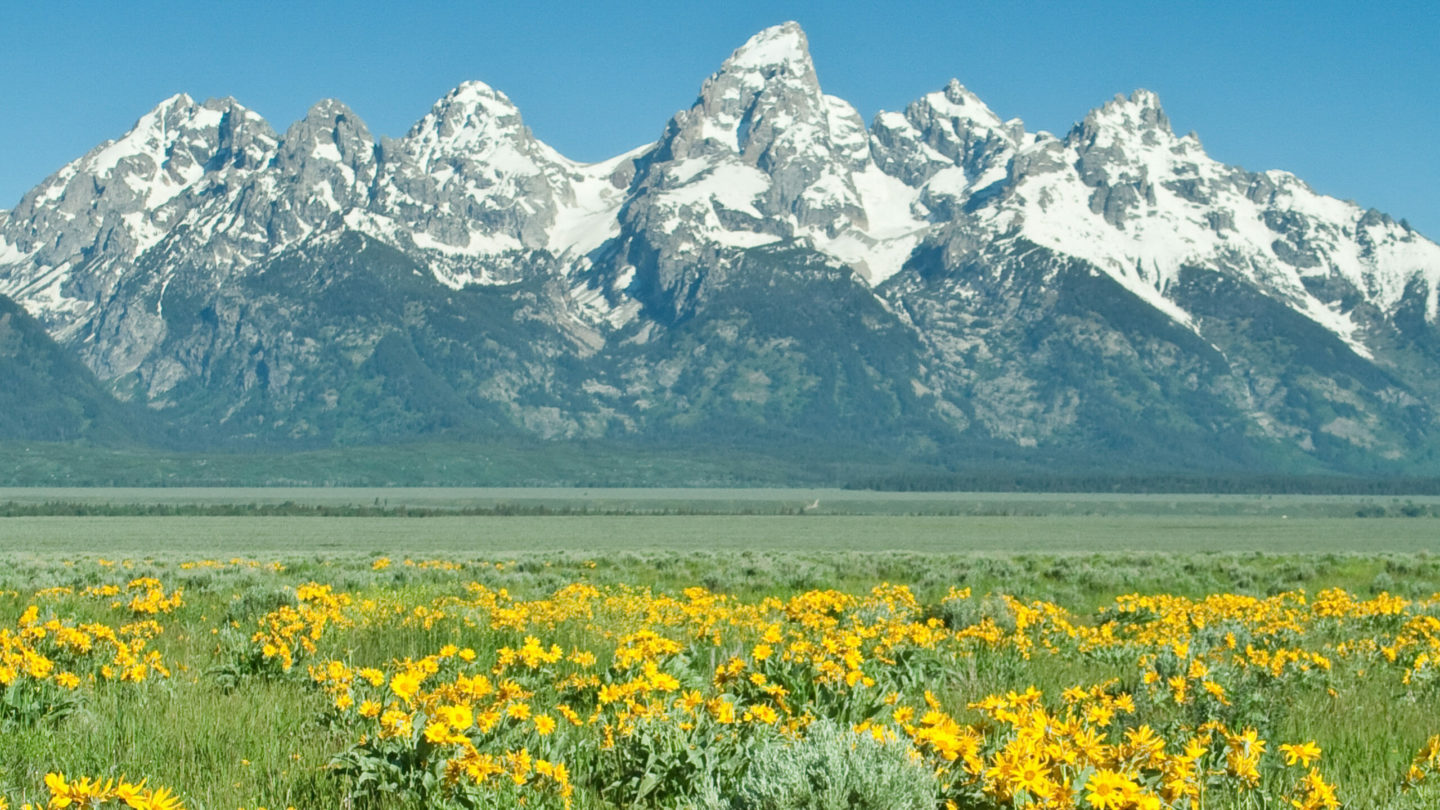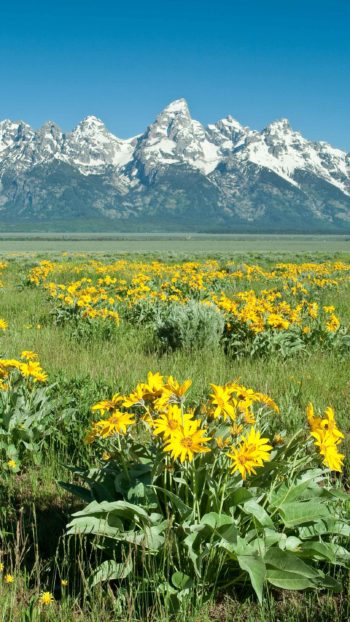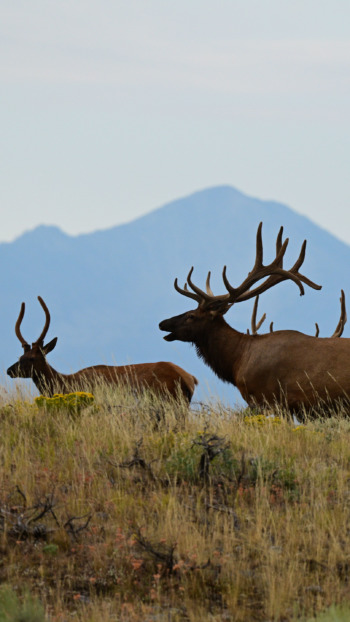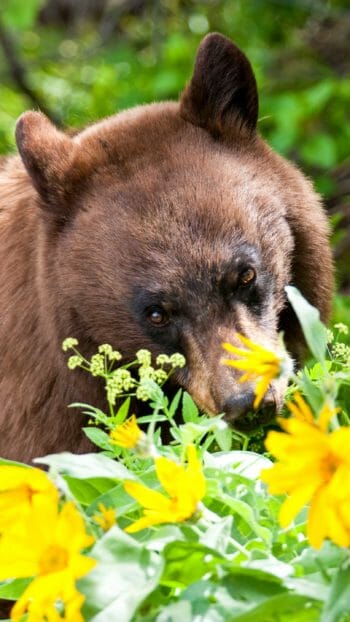One of the most breathtaking mountain ranges in the U.S. is located in Grand Teton National Park. The pristine lakes and alpine terrain are made more spectacular by the profile of the Teton Range that acts as a backdrop like something out of a dream.
The unique landscape of rocky mountains and dense forests has equally interesting wildlife to match. Explore some of the beautiful fauna you will find in Grand Teton National Park that you should be on the lookout for during your next visit.
The Teton Mountain Range- stretching north to south for approximately 40 miles, and from the iconic east side view in the Jackson Hole Valley, the tallest peak towers nearly 7,000 feet above your head. This titanous granite mountain range appears to rise straight up out of the ground, with little foothills leading up to those jagged high alpine peaks. Geologists estimate the Teton Range formed 8-10 million years ago, along a fault line in the tectonic plate where two sides of that massive slab of bedrock slid in opposite directions. As a result, viewing these mountains from Grand Teton National Park you’ll find yourself admiring the sheer rocky face of a tectonic plate that was thrust skyward overtime, and still continues to rise to this day.
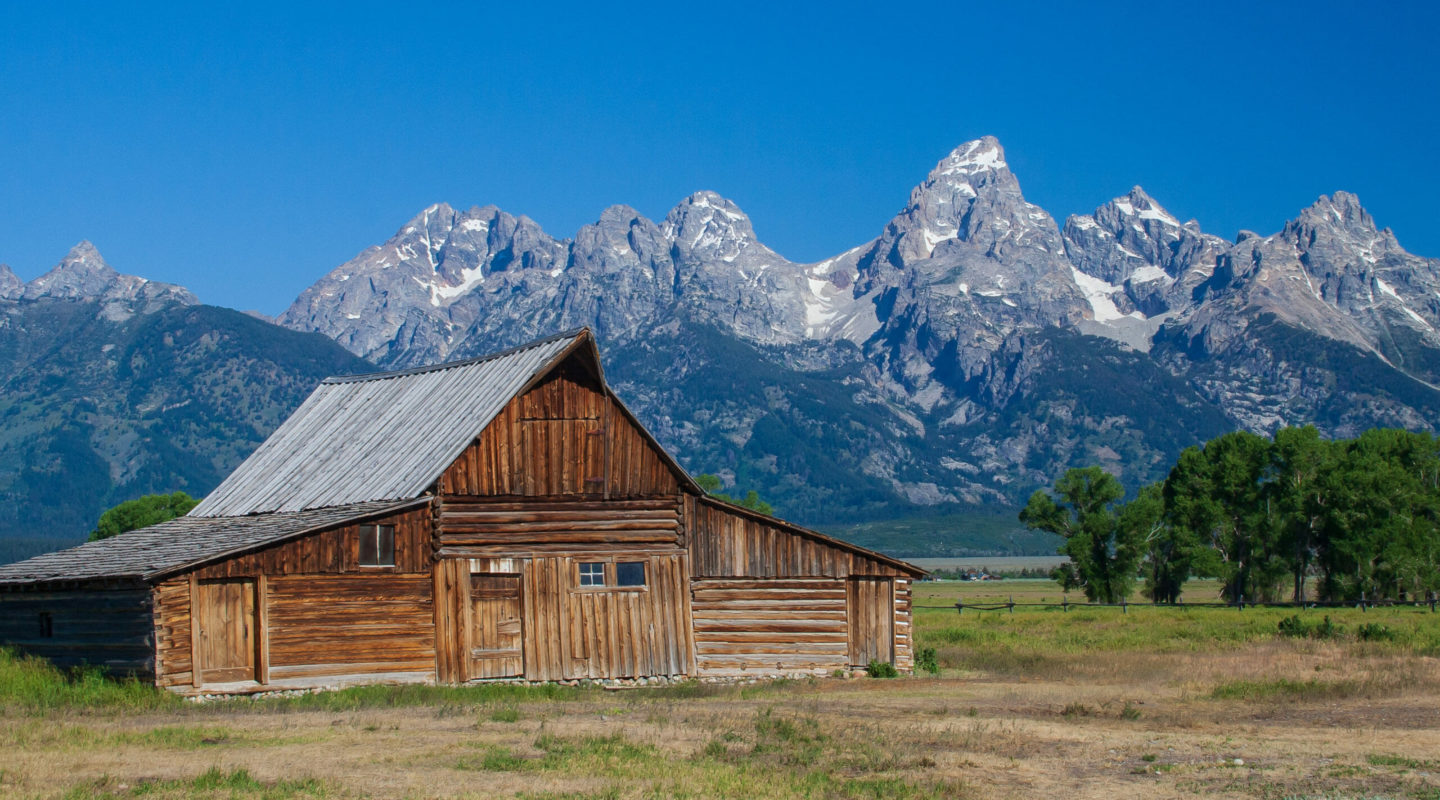
It is no wonder that advocates of the National Park Service wanted to preserve both the mountains and valley. Not only are the views mind blowing, but upon further inspection you may notice the sheer variety of habitat in this 300,000 acre park as well. There is the flat expanse of the sagebrush steppe of the valley floor, bisected by the winding Snake River which creates riparian habitat such as cottonwood galleries and willow thickets. Where soil quality is more nutritious and moist grasslands thrive, and as you move above the valley floor the dense pine forests begin to carpet the mountainsides. Reaching the high alpine peaks of the Tetons the trees give way to exposed rocky tundra and talus slopes, where glaciers and permanent snowfields can weather the heat of summer.
With this grand spectrum of natural landscapes comes a great diversity of wildlife. So many different incredible species have evolved to survive in an area that has summer temperatures that could exceed 90 degrees Fahrenheit, yet can succumb to eight months of winter where temperatures might drop to 30 degrees Fahrenheit below zero. The Teton Mountain Range itself typically accrues an average of 500 inches of snow every year! Whether it be in summer or winter, in the valley or up on the mountainsides, there are always exciting animals to look for in Grand Teton National Park.
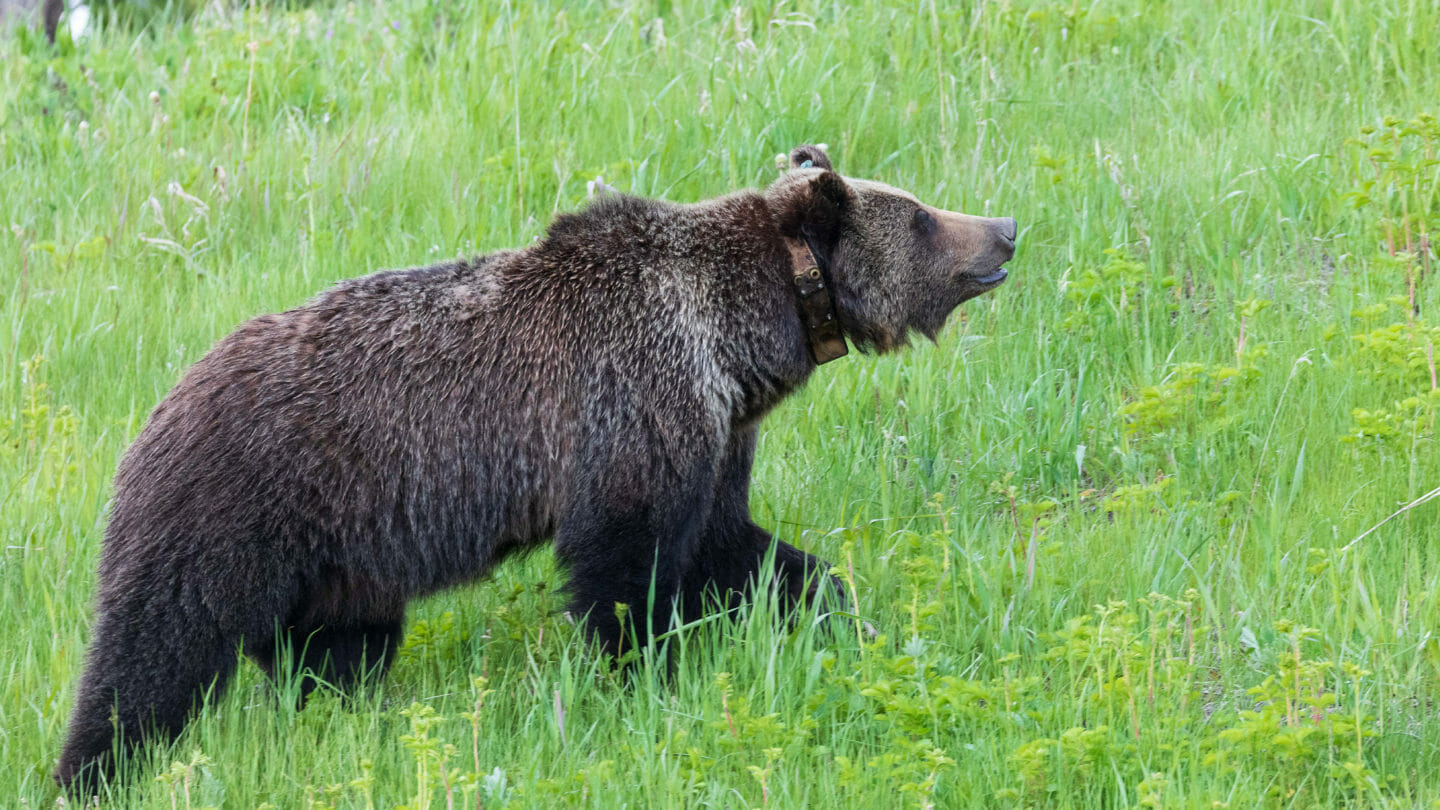
Bears
Grizzly and black bears are some of the most iconic wildlife found in Grand Teton National Park. There are plenty of viewing areas in the park that overlook grassy meadows and scenic ponds that are perfect for spotting bears.
The National Park Service emphasizes the importance of practicing bear safety throughout the park. If you do encounter a bear, maintain a safe distance of at least 100 yards. Bring binoculars, a spotting scope, or a long lens camera for a better look while staying far away from wildlife.
If you’re out on a safari with us, you’ll have access to binoculars and a spotting scope so you can view wildlife in Grand Teton National Park without disturbing them.
Many visitors to Grand Teton National Park have bears right at the top of their list for wildlife that they want to see. These are some of the largest land dwelling carnivores in North America, and often are not the easiest to find because they thrive best in some of the wildest, untamed landscapes. Fortunately the Jackson Hole Valley harbors healthy populations of both black bear and grizzly bear! In early spring the bears begin to wake up from hibernation, typically in late April to early May for grizzlies, and late May to early June for black bears. During this time frame both of these bear species will stay lower in the valley, seeking out food where there is less snow to navigate through. Grizzly bears with their four to five inch long front claws will dig through deep snow drifts to uproot carcasses of animals that did not make it through winter, or rake through the rocky soil to uproot the hibernation dens of ground squirrels and other small mammals. Both black and grizzly bears will also be searching for middens of pine nuts stored by hibernating red squirrels that usually will not wake up until late May.
This is an exciting time to search for bears, because they are typically on the valley floor and therefore closer to roadways. That means you could be driving through Grand Teton National Park and suddenly have a bear navigating down the same roadway you are! It is important this time of year though to keep in mind no matter how close a bear wanders to a road, you need to stay at least 100 yards from that animal, which might mean viewing it from the safety of your vehicle after you have pulled over to avoid obstructing traffic flow. Something fascinating that has happened in this park is that female grizzly bears have learned to keep their cubs near roadsides in order to keep their babies safe from male grizzly bears (also known as boars). That is because infanticide is common amongst this species, a boar always wants to prioritize passing his own genetics to future bear generations, and as long as a female bear already has cubs she will not want to breed. Therefore, a boar will kill the cubs currently with a mother bear in order to force her back into estrus so he can then breed with her. Though the origin is somewhat bleak, these “road bears’ ‘ create incredible opportunities to view such massive carnivores and (adorable) cubs from a rather close proximity.
Throughout July and August bears will move into shady forested areas or into the higher elevation mountains in search of cooler temperatures and other plants to feed on. There are areas in the Tetons where you can scan mountainsides from the valley floor to seek out black bears roaming the lusher, greener grassy slopes. This often requires binoculars and high powered spotting scopes in order to get a clear view of an animal that could be 2000+ feet above you. By mid-July is when the first wave of berries ripen up for the season, this is the huckleberry. This fruit is typically found in pine forests, as it prefers the shadier understory to grow in and also more acidic soil, which decomposing pine needles increase the acidity of the dirt. A great spot to look for bears feeding on huckleberries is the Signal Mountain Summit Road, keep an eye out for low growing shrubs around the bases of the lodgepole pines that line the roadway. This can also be a good spot to taste test some huckleberries too! Just make sure you are not getting close to any bears.
Now Autumn, which starts about mid-September in Grand Teton National Park, is similar to spring for bear sightings. During this time frame even more berry species begin to ripen up, and on top of that, the bears typically begin to go into a stage of hyperphagia. Hyperphagia drives a bear to essentially overeat and pack on fat, which is going to prepare that animal for hibernation. Western serviceberries, hawthorne and chokecherries will start fruiting in the fall, and both black and grizzly bear will be seeking out those shrubs. There will be enough berries for bears to be closer to each other than they might normally be, and you could potentially see 10+ black bears in a mere 10 mile stretch of road! The Moose-Wilson Rd is a prime spot to look for bears during this time of year.
If you are coming to Grand Teton National Park with the primary goal of seeing bears, make sure to plan for the right time of year and also consider finding a local guide to help! Once again, Grand Teton National Park is about 300,000 acres in size, and if you only have a few days to look for wildlife a guide can provide valuable insight, as well as important tools like spotting scopes, to help you succeed. An experienced guide will also help make sure you are viewing these potentially dangerous animals as safely as possible, by making sure you maintain a safe distance and will also be carrying bear spray in case something unexpected happens.
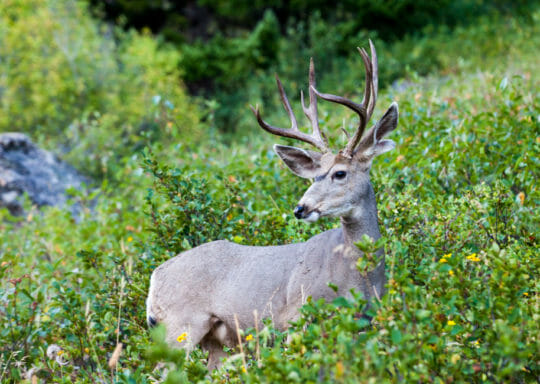
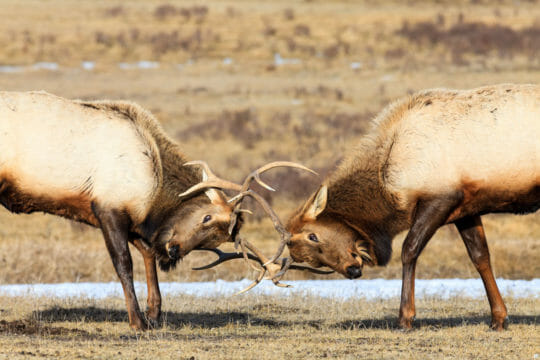
Elk, Deer, and Moose
Elk, mule deer, and moose are all ungulates that you’ll find in Grand Teton National Park. They prefer the wooded areas, marshes, and fields, rather than rocky cliffs that are home to bighorn sheep.
The National Park Service claims that the best place to observe these majestic animals is Cascade Canyon. Located near Jenny Lake, you might catch deer and moose munching on grasses and willows while pikas and yellow-bellied marmots dart behind the boulders scattered around.
When you travel with a professional guide, you benefit from the knowledge they have of the local wildlife and their daily movements through the park. While wildlife sightings can’t be guaranteed, the best chance of seeing these animals is with a guide.
There are three members of the deer, or cervidae, family found in Grand Teton National Park: deer, elk and moose. Many visitors hope to see these ungulates with full sized antlers, posing with grandeur in front of the majestic mountains. While this can happen, it is not the most common way you’ll end up spotting either of these species. The first thing to keep in mind is that only the males will have antlers, and unlike wildlife with horns (such as bison) antlers are shed and grown back every year. Which is quite a feat, considering a moose antler could potentially weigh as much as 40lbs… each! Typically moose and deer will shed their antlers starting in December, while elk may not drop theirs until March. At one to two months after the antlers have fallen off antler buds will begin to form, which start as small bumps right above the eyes of the animal. By spring, deer, elk and moose could potentially be growing as much as a quarter, to one full inch of antler a day! During this period the forming antler will be coated in a thin, fuzzy tissue called velvet, which supplies blood and nutrients to the cartilaginous structures. By late summer the antlers should be about done growing and will begin to mineralize into bone, the velvet will soon begin to die off and the male will scrape off this tissue to expose the bone underneath. This is all in preparation for a fairly exciting time of year to view these animals- rut.
Rut, which takes place September through October, is the breeding season for deer, elk and moose. This is when the males will have fully grown antlers, which serve as a display of their health, age and strength. Elk and deer are usually accruing harems of females they will breed with, and one male could potentially have as many as 10-30 females with him at once! Moose on the other hand are a more solitary animal, while one dominant male may breed with a majority of the females he typically will not gather them into one group. Elk might be one of the most exhilarating animals to observe during rut, and perhaps the noisiest. Iconic to the bull elk is the bugle, a high pitched keening call which acts to attract females and also ward off other males that might try to breed with females already in a harem. It is an amazing, ethereal sound to witness first hand. Now it is not typical to see two males of either species fighting during the rut, because it only really happens when two males of similar size and strength encounter each other. Most of the fight actually happens through sight and sound, with one of the challengers often backing off after realizing he doesn’t stand a chance. However if you do get lucky to see a deer, elk or moose go head to head it is quite the remarkable battle that could result in one of them being injured or even killed.
With a little more insight into the behaviors and biology of the cervidae Family, you might now be wondering “Where do I find them?” This is a different story for each of these animals and it changes throughout the seasons. How about starting with the largest member of the deer family, the moose. This animal can potentially weigh up to 1,200lbs and reach heights of 7-8 feet. You would think this would make them the easiest to find, but the reality is moose can be one of the trickiest. Unlike elk and deer which frequently graze in open grasslands, moose typically are feeding on tips of willows and cottonwood tree branches, or submerging themselves in rivers, ponds or lakes to forage on aquatic vegetation. This means they can tuck themselves away in some of the densest of willow thickets and be near impossible to find unless you know what you are looking for! Great spots to look for moose would be along the Gros Ventre and Snake River, which there are multiple viewpoints to access for both of these waterways in the park. In winter, spring and fall the moose can be foraging throughout most of the day, however when the heat of summer descends on the landscape they often become elusive during the hottest parts of the day. Morning and evening become the best times to seek out this animal, unless you happen to know where one might like to bed down in the shade for the middle of the day.
Elk are another animal that become crepuscular during the hottest parts of summer, meaning they are most active at dawn and dusk. Usually mid-June through August is when elk will bed down or graze in the forest where it is shady, sometimes even trekking up into the Tetons during that time frame in search of cooler temperatures. Traveling roads through forested habitat such as the Signal Mountain Summit Rd or the Jenny Lake Scenic Loop is a good idea if you are looking for elk in the middle of the day in summer. Come Autumn is the rut, which means earlier or later in the day begin searching (and listening) around the open sagebrush steppe of the valley floor for bull elk and their harems moving out of the trees. Winter might be one of the most exciting times to see the elk of Jackson Hole. Migrating from Grand Teton National Park, and some coming from as far north as Yellowstone National Park, elk will move into the National Elk Refuge, which is lower in elevation and overall accumulates less snow than the parks up north. An average of 7,000-8,000 elk will winter in that area every year.
Grand Teton National Park hosts two species of deer, the mule deer and whitetail deer. Both are similar in their habitat preferences, as well as appearance, with one of the greatest differences being the whitetail having that iconic fluffy tail which is white only underneath, and the mule deer having a smaller, entirely white tail with a black tip. In summertime the deer are easiest to find foraging in forested areas, similar to the elk. The deer often roam roadsides as they have learned there are typically fewer predators in those areas. The Moose-Wilson road is a great spot to drive along in search of deer, as it is densely forested and has an ample amount of vegetation in the understory for them to feed on. Similar to what you might witness in your own yard, it is not uncommon to see deer around the town of Jackson as well. Especially in wintertime when the park is so inundated with snow it is more difficult for the deer to survive. Instead this wild animal lets us do the work of plowing roadways, sidewalks and yards and then takes advantage of these easier paths of travel.
It is important to keep in mind that even though deer, elk and moose are herbivores they can still be dangerous. The National Park Service requires everyone to maintain a distance of 25 yards from these animals, which is still quite close! More people are hurt by these ungulates than bears every year, usually because people choose to get too close. Even when maintaining a distance of 25 yards keep a close watch on this variety of wildlife, as they can move quickly and if you notice one seems agitated by your presence you should back away and give it more space.
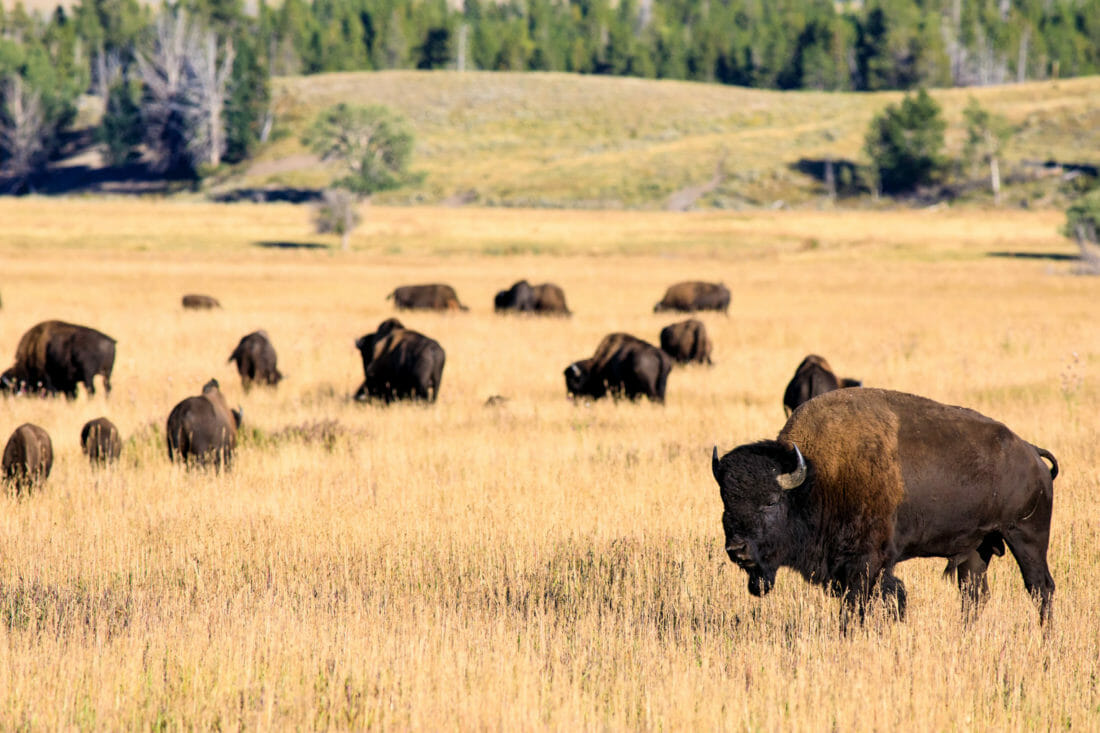
Bison
Another icon of the wild Wyoming range is the American bison, and the best place to observe them is north of the town of Jackson, in the flood plains near the Snake River. Herds of bison, elk, and even the occasional moose are often seen grazing in the lush meadows on either side of the river.
Along with these large mammals, you may even see bald eagles, ospreys, and great blue herons finding their dinner in the river or soaring overhead in the sky. You might even catch sight of a beaver lodge or a playful otter along the riverbanks.
Bison are both the largest land mammals in North America, and are revered as one of the true icons of the American West. The bulls could potentially weigh as much as one ton, or 2,000lbs, and the cows typically max out at 1,000lbs. This massive animal typically thrives in open grassland habitat, which combined with their size makes them some of the easier wildlife to find in Grand Teton National Park. One of the best times of year to look for bison is May, this is when the females begin giving birth to their calves, which start out at only 40lbs! Still a big baby, but compared to the mother that’s a mere 4% of her weight. A great spot to look for bison during this time frame is Elk Ranch Flats, where it is open and grassy and you could potentially see hundreds of these animals at once. Be careful driving through this area however, bison are not afraid to walk across roadways or even stand around and obstruct traffic. Bison are also another animal you are legally obligated to stay 25 yards away from, however they are big enough and quick enough it is not a bad idea to give them more space than that.
The breeding season for bison is in August, and is another exciting time to observe these animals. One ton bulls will be roaming the open grasslands, releasing guttural bellows while courting females and warding off challengers. The males during this time hardly eat, drink or rest as that will take away from their one goal- to copulate with as many females as they can and pass on the most genes possible. Aside from the vocalizations the bulls make, they will also find dusty patches without any vegetation to roll around in, putting on as much of a show of strength that they can to attract potential mates.
The middle of summer and winter can both be challenging times to find this massive beast. They often will migrate into areas where food and water is more easily accessible. This is when the insight of a guide is very valuable, since they are moving around the park on a near daily basis and know the most up-to-date info on wildlife whereabouts. You of course don’t want to risk missing one of the largest land animals in Grand Teton National Park!

Don’t Forget the Little Guys
While these large mammals are must-sees when you visit Grand Teton National Park, they aren’t the only wildlife around. Whether you’re hiking a mountain trail or stopping at a designated lookout on the road, you will see plenty of smaller critters roaming around, like ground squirrels, beavers, coyotes, and a number of avian and insect species.
Grand Teton National Park wildlife is a must-see when visiting Jackson Hole. Our professional naturalist guides know the best places to safely observe the unique animals of the American West that will be the highlight of your adventure.
Most of the wildlife mentioned so far are going to weigh in at about 100-2,000lbs at maturity. Which is, of course, an amazing sight to behold, but what about all the numerous little critters you can potentially see? Perhaps while seeking bison in the grasslands you notice little hamster-like creatures darting in and out of holes in the ground. These are Uinta ground squirrels, often mistaken for prairie dogs, which are not found in Grand Teton National Park. They are about as much fun to watch though! The open flat-lands of the Jackson Hole Valley is also habitat for numerous other mammals like badgers, coyotes, fox, skunks and weasels, to list a few.
When seeking moose in riparian or marshland habitat, keep an eye out for beavers, river otters and muskrats! Searching for wildlife along waterways is also a great way to find a variety of avian species too, such as the bald eagle, osprey, blue herons, geese, swans, teals and mergansers. Forested areas are fruitful areas to find red squirrels, American martens, porcupines, woodpeckers, owls and a massive variety of woodland songbirds. If you find yourself hiking up into the high country of the Teton Mountains, along with bighorn sheep, you could also stumble upon yellow-bellied marmots sunbathing on boulders, dusky or ruffed grouse meandering through the trees, or if you are out in the evening the higher elevation forests are also home to rare small mammals such as the flying squirrel. Truly, no matter where you go there is almost always some form of wildlife to be found!
FAQs
What animals can you see in Grand Teton National Park?
The animals of Grand Teton National Park include bison, elk, moose, mule deer, and pronghorn. You might also spot black bears, grizzlies, coyotes, or wolves. Birdlife is abundant too, with bald eagles and sandhill cranes among the highlights. From valley floors to mountain slopes, Grand Teton National Park wildlife is diverse and thriving—making every visit a chance for incredible sightings.
What's the best way to see wildlife in Grand Teton National Park?
The best way to see Grand Teton National Park wildlife is on a guided wildlife safari. Expert guides know the top viewing areas and the best times of day to spot animals like moose, elk, bears, and wolves. Early mornings and evenings offer the highest chances of sightings. Scenic drives through areas like Antelope Flats, Moose-Wilson Road, and Oxbow Bend are also excellent for encountering the animals of Grand Teton National Park in their natural habitat. Bring binoculars, stay a safe distance, and be patient—wildlife sightings can be both thrilling and unpredictable.
What kind of bears are in Grand Teton?
Grand Teton National Park is home to an estimated 400–500 moose, primarily from the Jackson Hole population. These iconic animals are most often seen near rivers and wetlands, especially along the Gros Ventre River, Moose-Wilson Road, and Oxbow Bend. While their numbers have declined since the 1980s, the population has remained relatively stable in recent years.
How many moose are in Grand Teton?
Grand Teton National Park is home to an estimated 400–500 moose, primarily from the Jackson Hole population. These iconic animals are most often seen near rivers and wetlands, especially along the Gros Ventre River, Moose-Wilson Road, and Oxbow Bend. While their numbers have declined since the 1980s, the population has remained relatively stable in recent years.
Where can I see wildlife in Grand Teton National Park?
Top spots to see Grand Teton National Park wildlife include the Moose-Wilson Road, Oxbow Bend, Antelope Flats, and the Gros Ventre River corridor. These areas offer great chances to view the iconic animals of Grand Teton National Park such as moose, elk, bison, bears, and even wolves. Early mornings and evenings are the best times for wildlife viewing.
Where is the best place to see bison in Grand Teton?
Elk Ranch Flats, located along Highway 89/191 near Moran Junction, is one of the best places to see bison in Grand Teton National Park. Large herds often gather here throughout the day, offering excellent viewing opportunities. Other great spots include Antelope Flats, Mormon Row, and Kelly Loop Road, especially during early morning or late afternoon when bison are most active. Always observe from a safe distance and use designated pullouts for viewing.

